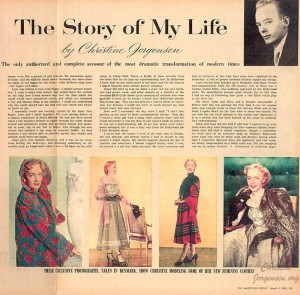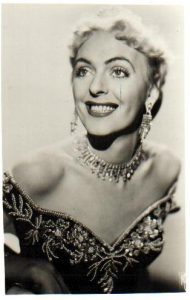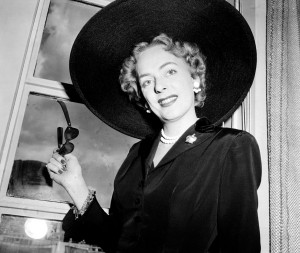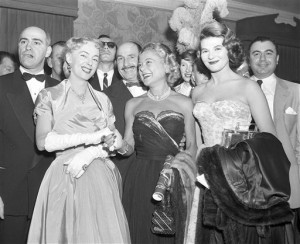The Most Important TG — Christine Jorgensen Part 1
By Kristina Mayhem
The transgender movement has a long and rich history and its most important person is Christine Jorgensen. She became a worldwide sensation in 1952 when a sex-change operation transformed her from a man into a woman. People were captivated, as most were unfamiliar with what transgender means. Many were startled to learn a person could change their sex, others were fascinated, and some found a role model to call their own.
Jorgensen’s instant rise to stardom led to a career as an entertainer and made her an authority. Her stage show poked fun at gender-switching, but she defended herself strongly in interviews and writing. She didn’t waver from her right to be a woman, and for others to recognize and respect that right. She was a pioneer who faced many challenges, transcended them, and helped others find strength in a difficult world.
Jorgensen’s fame started with a bold headline on the front page of the New York Daily News. People sat down with their morning coffee to read how an “ex-GI” became a “blonde beauty.” It was a splashy front-page article with before and after pictures that told how an Army veteran changed his sex. Sixty years later, her name has all but disappeared; a sex change is no longer front page news, but she was once the most publicized person on earth and the world’s most talked about figure. Jorgensen went from being a nameless person recovering from sex-change surgery in Denmark to becoming a celebrated figure who set records for newspaper coverage.
When her story broke, she could not have imagined how big it would become. She was still recuperating in bed when large numbers of letters, phone calls, and cables started pouring in. One reporter said “All of America is anxiously awaiting a statement from you (Jorgensen, 1967, p. 131).” Everything started when a newspaper reporter named Ben White interviewed her while she was transitioning in Denmark and pursuing her career as a filmmaker (Docter, 2007, p. 119). Because of the controversial nature of the subject matter, it was decided that she would play the role of a reluctant participant. Everything was made to appear like it happened without her knowledge or consent after her family did a reluctant interview.
 All this media attention would make one think Jorgensen was the first person to have a sex change operation. The reality is that sex changes began decades earlier in Germany, and by some accounts are a centuries-old procedure. There were already many news stories about sex changes and crossdressing in newspapers before her story broke (Terry, 2012, p. 4). What made Jorgensen’s story unique was the bold headline and large close-up pictures. Her femininity shone brightly, and her physical attractiveness created an added element of interest. She also had a charming personality and an ease in social situations that promoted her appeal.
All this media attention would make one think Jorgensen was the first person to have a sex change operation. The reality is that sex changes began decades earlier in Germany, and by some accounts are a centuries-old procedure. There were already many news stories about sex changes and crossdressing in newspapers before her story broke (Terry, 2012, p. 4). What made Jorgensen’s story unique was the bold headline and large close-up pictures. Her femininity shone brightly, and her physical attractiveness created an added element of interest. She also had a charming personality and an ease in social situations that promoted her appeal.
This was an important selling point for transgender people. The world saw an ordinary person with a benign variation. Her behavior was legitimate, genuine, and based on acceptable principles of reasoning. She said everyone has male and female hormones and no one is completely one gender or the other. People saw that male and female were not polar opposites, and it was a simple logic that was easily understood. She used this explanation so much it became her mantra (Meyerowitz, 2002, p. 97). Her reasoning was grounded in science, and she was firm in her resolution. She once walked off a popular talk show when the interviewer made an undignified remark that questioned her legitimacy. The interviewer spent the remainder of the show sitting by himself explaining his actions (Cavett, 1968).
 Historical context gives insight into how Jorgensen’s story garnered the attention that it did. Science and technology played important roles in the Cold War era following World War II. People saw advancements in science and medicine triumph over human nature. Gender beliefs became less rigid as more women worked outside the home, and this opened the way for social change. Political changes such as the sexual revolution and gay-rights became part of the landscape. A hushed subject such as sex could be discussed more openly and a sex-change operation was now part of the discussion. Christine Jorgensen called it the “opening of the sexual understanding explosion (Meyerowitz, 2002, p. 52).” This was also the age of Hollywood and a new starlet who resembled Grace Kelly was on display for people to observe and judge. Jorgensen’s name became synonymous with sex change, and references to her abounded in everyday culture.
Historical context gives insight into how Jorgensen’s story garnered the attention that it did. Science and technology played important roles in the Cold War era following World War II. People saw advancements in science and medicine triumph over human nature. Gender beliefs became less rigid as more women worked outside the home, and this opened the way for social change. Political changes such as the sexual revolution and gay-rights became part of the landscape. A hushed subject such as sex could be discussed more openly and a sex-change operation was now part of the discussion. Christine Jorgensen called it the “opening of the sexual understanding explosion (Meyerowitz, 2002, p. 52).” This was also the age of Hollywood and a new starlet who resembled Grace Kelly was on display for people to observe and judge. Jorgensen’s name became synonymous with sex change, and references to her abounded in everyday culture.
Despite this new world and its broader understanding of gender, press coverage was not always positive (Terry, 2012, p. 10). Articles followed the original news story that were skeptical in nature and referred to her in the wrong pronoun. Negative articles emphasized a lost masculinity rather than a newfound femininity, and reflected disillusionment warring with captivation. A competing newspaper published articles claiming she was a woman in name only. Some articles pathologized her, using the differences in opinion to create controversy and generate sales (Terry, 2012, p. 20). A weekly news magazine called Quick said she was not a “real woman” and called her a “mentally ill transvestite.” Time magazine accused her of exploiting her transition to make money (Terry, 2012, p. 13). Her news coverage was usually one of two extremes; complete hostility or total approval, and she was attacked or celebrated depending on which was more profitable at the time.
Christine Jorgensen’s life began on May 30, 1926 when she was born George Jorgensen in New York. She grew up in Manhattan with her parents and an older sister in a working-class socially involved family (Docter, 2007, p. 22). She had a normal childhood, although she was bullied in her early years in school. How much she crossdressed and how much she liked men was uncertain. Her autobiography says she did not dress in women’s clothes until she was an adult, thereby abiding by legal and social proprieties. Given that crossdressing plays a strong part in transsexual development, many find this hard to believe. Other sources say she admitted a lack of candor about her life, and indeed crossdressed in her earlier years (Meyerowitz, 2002, p. 52). Some sources say she wore her sister’s dresses and confessed to a doctor about crossdressing as a youth (Docter, 2007, p. 30 & 257). Some people remembered her as being socially withdrawn, but others remembered her as outgoing, athletic, and confident. The positive traits are the kind important for accomplishments she eventually made.
After graduation, she had a brief stint in the Army and enrolled in college under the G.I. Bill, but was distracted by “ever-present personal problems (Jorgensen, 1967, p. 60).” She was struggling with the kind of traumatic and debilitating problems that transgender people have. She also had questions about her sexuality and reported putting on an acceptable front when asked about dating girls, even though there was turmoil and she searched blindly for answers before coming to terms with her attraction to men. She built a wall around herself and felt isolated, confused, and that life was an affliction. The body of transgender information was much smaller then, and she was unsure of herself. She reports that she did not like falling in love with men, although evidence shows her attraction to men was greater than her autobiography reveals (Docter, 2007, p. 209).
She shared her story with a local physician who recommended abolishing her feminine inclinations, which she did not want to do. She read about similar situations in libraries and was influenced by Paul De Kruf’s book, The Male Hormone. She found solace in his explanations of hormonal imbalances as being the cause, and self-administered hormones she found on her own. European doctors knew more about gender transition than American doctors, so she traveled to Europe in hopes of a remedy. She purchased a one-way ticket to Copenhagen and waved good-bye to her family, who did not know the purpose of her voyage. In Europe she met a doctor who provided the help that she needed. She spent almost three years getting hormone therapy to complete her transition, and then underwent surgery. She began living as a woman after her second surgery, which is when her headline news story broke.
To be continued next month.
Category: Transgender History













Hello:
I was very lucky that during the mid-1960’s in Chicago, Illinois (when I was just a teenager) I got booked at a very popular local TV program and also dear Christine Jorgesen was too…she was elegantly dressed and she was very nice too(and when she saw me dressed up as Judy Garland) she told me that it was her who suggested to Judy when she got heavy because Judy was suffering from some type of liver ailment at that time to wear an ample, colored sequenced top to make her look thinner when she was performing on-stage.
That’s the only time I got to meet the legendary Miss Jorgensen….may she rest in peace!
Just wanted to share this little anecdote with you all at the TG Forum.
Sincerely,
Finocchio’s David de Alba.